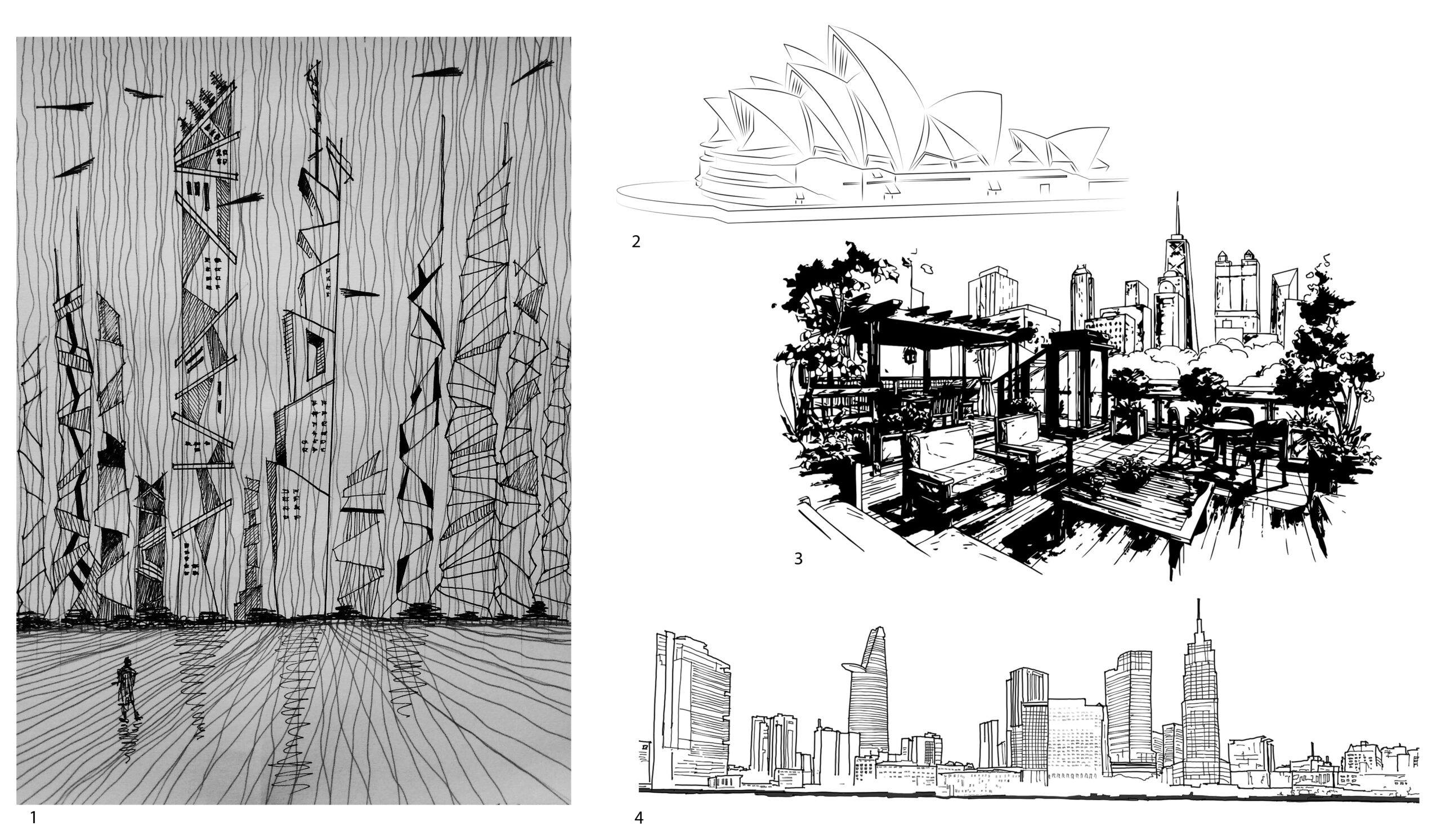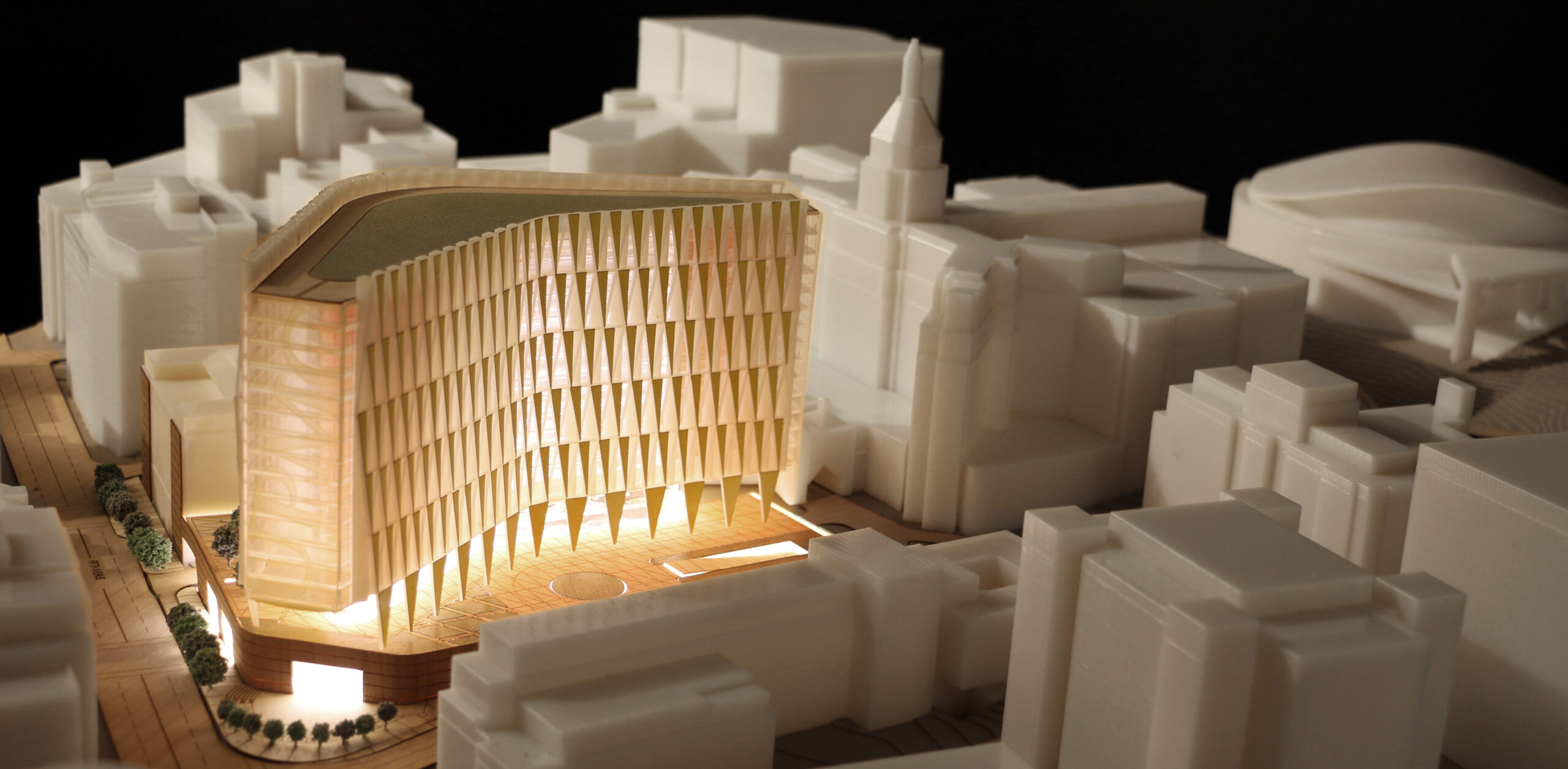Calling all hand drawers and AI enthusiasts! With special categories dedicated to Hand Drawing, Computer-Aided and AI-Aided representation, Architizer’s Vision Awards is celebrating the strengths of diverse types of Architectural Visualization and the creators behind them. Learn more and start your submission.
Sketching is a thinking tool that reflects one’s knowledge and emotional interpretation. The outcome of sketches is not necessarily a final product but a representation of ourselves engaging in a process, who we are, and how we think: I sketch, therefore I am.
AI design tools can certainly boost efficiency, saving time and resources. But should AI design tools replace sketching for the sake of practicality and speed?
We must acknowledge that these tools pave the path to innovative and fascinating forms of architecture, so why not embrace them to find a balance between human sensibility and technological efficiency to bring out the best of design?

1. Skyscrapers. Image by Victoria_Watercolor from Pixabay; 2. Sydney Opera House. Image by romavor from Pixabay; 3. Outdoor terrace. Image by Victoria_Watercolor from Pixabay; 4. City skyline sketch. Image by YUSUKE KOIKE from Pixabay.
The Unique Beauty and Vague Accuracy Of Sketches
Technical accuracy is not the goal that architects generally pursue when sketching. Instead, they are after a compelling visual representation as a medium for dialog and to communicate ideas with individual expression. Mediums are endless, and the more we look at this rich variety, the more sketches appear exceptional.
As visual displays of the thinking process, sketches can stimulate reflection, facilitate exploration and approach situations from different perspectives. As Iain Fraser and Rod Henmi put it in their enlightening book, Envisioning Architecture: An Analysis of Drawing: “Drawing is not a transparent translation of thought into form, but rather a medium that influences thought just as thought influences drawing.”

Synagogue sketches . Image by Moti Bodek of Bodek Architects via Wikimedia Commons (left); annotated marker sketches. Image by Image by Andika Murandi via Flickr (right).
Sketches as a Communication and Problem-Solving Tool
Sketching is a universal language that gives ideas visibility. It communicates ideas and helps designers think, question, organize and improve. Knowledge and memories accumulated produce items associated with form, texture, material and structure, from the imaginary to the visual form. The process is not linear but can take different paths guided by the information input through a fast flow of thoughts. The outcome generally is a series of solutions or options, which later are developed and fine-tuned, narrowing down the possibilities to an optimal result.
Yet, the process is long and time-consuming. With AI tools gaining increasing attention, we may have reached a point where sketching is an outdated and inefficient way to communicate ideas. Yet, AI tools are perhaps not quite prepared to express the complex design nuances that human sensibility is capable of transmitting. Would this be a strong enough argument to make sketching irreplaceable?

25 variations of an industrial warehouse made with the AI text-to-image software Midjourney. Image by Kevin Dooley via Flickr.
Promoting Creative Solutions
How can AI tools be used to help to optimize the outcome of a design? Should AI design tools replace sketching for the sake of practicality and speed? AI design tools can certainly boost efficiency while saving time and resources. We are also observing how these same tools pave the path to innovative and fascinating forms of architecture. Design practice should explore digital tools that can promote creative solutions and lead to interesting and advantageous design processes.
Midjourney, DALL-E 2 and Stable Diffusion are text-to-image converters juggling images, text, sound and videos. They are popular among architects. Nuno Fontarra, a partner at Mecanoo, states that “just like hand sketching, it’s become a dialogue”, enabling architects to explore diversified solutions with endless possibilities. While Fontarra admits that the technology’s ability to produce results rapidly will contribute to a more expeditious workforce, it will need to evolve to achieve goals as a precision tool.

Artificial Intelligence. Image by Gerd Altmann via Pixabay.
A Mind Without a Body and a Skill With No Soul
One may argue that machines with artificial intelligence have minds. In this respect, Oliver Whang, in his article “Can the Mind Be Separated From the Body?,” published by The New York Times, says that “researchers doubt that without a true connection with the physical world, they will never be able to display crucial aspects of human intelligence. The technology won’t reach true intelligence or true understanding of the world until is paired with a body that can perceive, react to and feel around its environment.”
AI is a promising asset in the creative process, but it has not yet reached actual creativity. However, sketching and AI tools can complement each other to develop exciting and advantageous design processes. Technology is indispensable, but it will be complementary until it evolves to a much higher level of sophisticated technology when it comes to sketching. On the other hand, the sketcher will ultimately be the decision maker with a soulful sensibility capable of generating unique solutions.
Calling all hand drawers and AI enthusiasts! With special categories dedicated to Hand Drawing, Computer-Aided and AI-Aided representation, Architizer’s Vision Awards is celebrating the strengths of diverse types of Architectural Visualization and the creators behind them. Learn more and start your submission.









